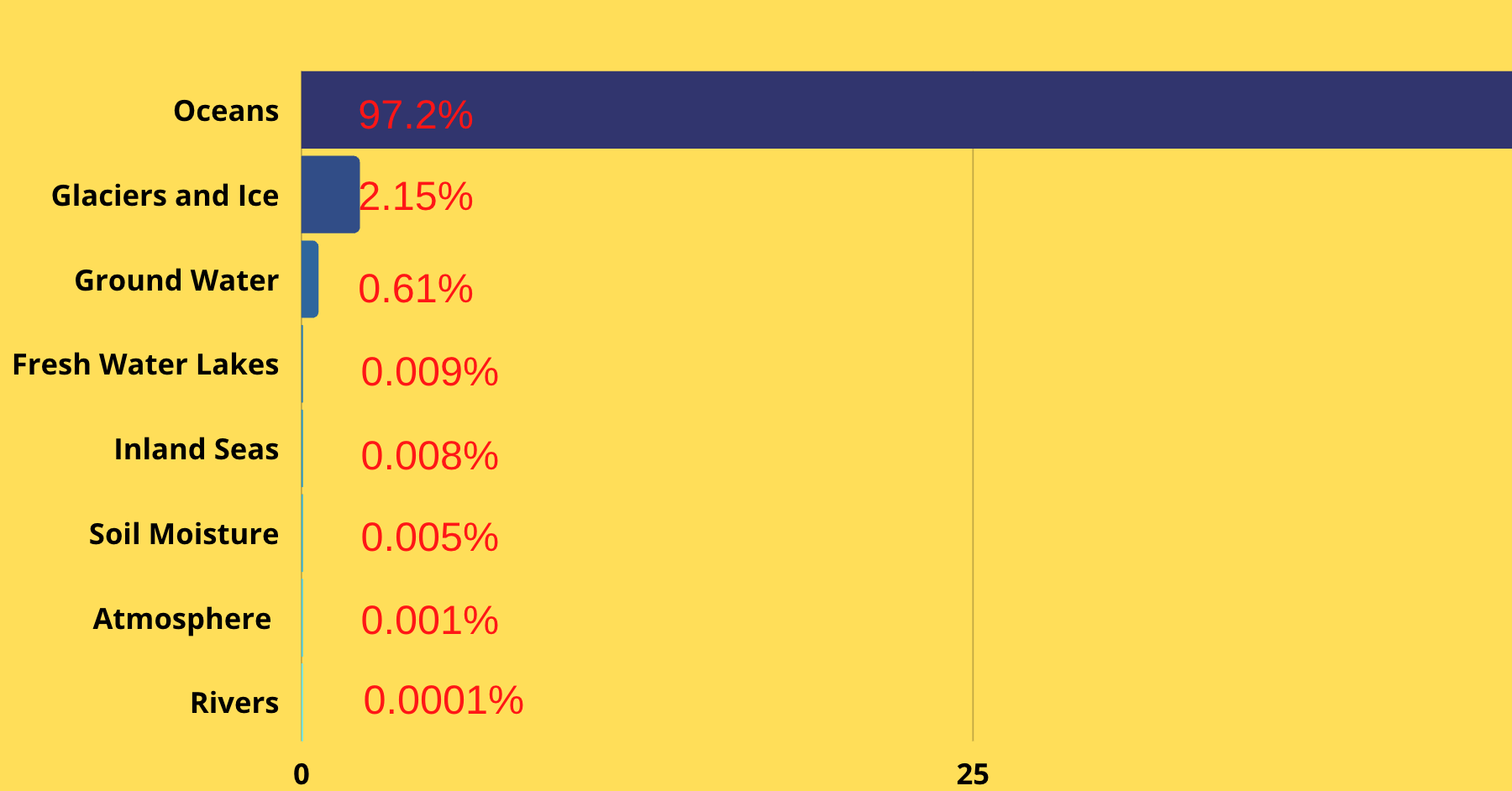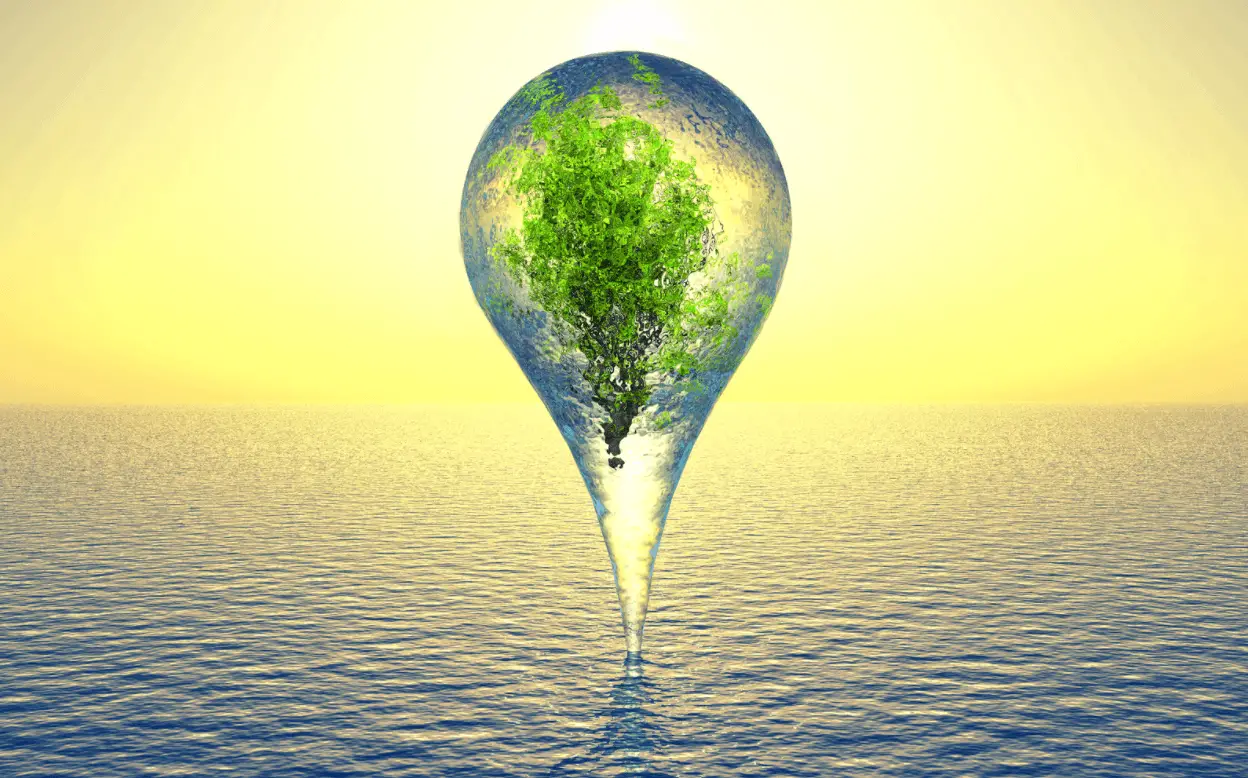- About 71% of the Earth’s surface consists of water, while continents and islands make up only about 29% of the Earth’s surface.
- Water also exists underground, in the air as water vapors, and in every living organism (even our body is up to 60% water).
- Our Earth is a blue planet with an abundance of water. However, humans use only a little percentage (about 0.3%) of this water. The other 99.7% exists in the oceans, ice-capes, soil, and in the form of water vapors in the atmosphere. Still, much of the 0.3% water that is usable by humans is inaccessible for many people.
Water Distribution On Earth
- The following is the percentage of the Earth’s whole water exists in different water bodies:
- Oceans: 97.2%
- Glaciers and ice in other forms: 2.15%
- Ground water: 0.61%
- Freshwater lakes: 0.009%
- Inland seas: 0.008%
- Soil moisture: 0.005%
- Water in atmosphere: 0.001%
- Water in rivers: 0.0001%

What Is The Location Of Earth’s Water?
- The total water supply of the world is about 332.5 million mi³, in which over 96% is saline while the remaining is freshwater.
- Over 68% of the total freshwater is in the form of ice and glacier reservoirs while another 30% is in the ground.
- Rivers are the major source of surface freshwater that people use, but it only makes about 509 mi³ (2,120 km³), which is about 1/10,000th of the total water. (All the percentages described here are round and may not add to 100).
- In the following table, an estimation of the world’s water distribution is shown:
| Water Source | Volume (in mi³) | Volume in (km³) | Round Percentage of Freshwater | Round Percentage of Total Water |
| Oceans, Seas, and Bays | 321,000,000 | 1,338,000,000 | ————– | 96.54 |
| Glaciers, Ice Capes, Snow | 5,773,000 | 24,064,000 | 68.7 | 1.74 |
| Groundwater | 5,614,000 | 23,400,000 | —————- | 1.69 |
| Fresh | 2,526,000 | 10,530,000 | 30.1 | 0.76 |
| Sline | 3,088,000 | 12,870,000 | ————– | 0.93 |
| Soil Moisture | 3,959 | 16,500 | 0.05 | 0.001 |
| Ground Ice And Permafrost | 71,970 | 300,000 | 0.86 | 0.022 |
| Lakes | 42,320 | 176,400 | —————– | 0.013 |
| Fresh | 21,830 | 91,000 | 0.26 | 0.007 |
| Saline | 20,490 | 85,400 | ————— | 0.006 |
| Atmosphere | 3,095 | 12,900 | 0.04 | 0.001 |
| Swamp Water | 2,752 | 11,470 | 0.03 | 0.0008 |
| Rivers | 509 | 2,120 | 0.006 | 0.0002 |
| Biological Water | 269 | 1,120 | 0.003 | 0.0001 |
🔬 Subscribe to SciMail
Get the latest science discoveries straight to your inbox!
How Much Water Exists In and On The Earth? here are some estimations:
- If all the water of the Earth is put into a sphere, then the diameter of that sphere would be about 1,385 kilometers (860 miles). The volume of all the water would be 1,386 million km³ (cubic kilometers) or 332.5 million mi³ (cubic miles). While one cubic mile of water is about equal to 1.1 trillion gallons and a cubic kilometer of water is about equal to 1 trillion liters (264 billion gallons).
- About 12,900 km³ (3,100 mi³) of water exists at a time in the atmosphere, mainly in the form of water vapors. If all this water fell at once in the form of precipitation, it would cover the Earth by only about 1 inch.
- The amount of water that evaporates every day into the atmosphere is about 1,170 km³ (280 mi³).
- Much of the Earth’s freshwater reservoir is in the form of glaciers and ice capes (29,200,000 km³ or 7,000,000 mi³) and the water stored in the ground (8,400,000 km³ or 2,000,000 mi³), mostly within one-half mile of the Earth’s surface. It is much more than the water found in lakes and rivers.


Leave a Reply